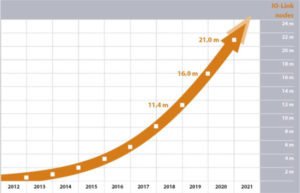Prevailing Trends
 The positive upwards trend of IO-Link continues, reflected not least in the node figures, which have once again been notarized for 2020. Compared to 2019, they have increased by 31% to reach approximately 21 million nodes by the end of 2020. Considering that the year was marked by a pandemic with the corresponding economic impact, this circumstance seems truly astonishing.
The positive upwards trend of IO-Link continues, reflected not least in the node figures, which have once again been notarized for 2020. Compared to 2019, they have increased by 31% to reach approximately 21 million nodes by the end of 2020. Considering that the year was marked by a pandemic with the corresponding economic impact, this circumstance seems truly astonishing.
Future-Ready
A rising number of machine and plant manufacturers are therefore using IO-Link as a modern interface for connecting sensors and actuators. The trend toward Industry 4.0 will further strengthen this path to communication, even down at the field level. The importance of condition monitoring and predictive maintenance will grow, and the need to obtain additional information for quality assurance and the optimization of entire manufacturing processes will become increasingly important. Information such as temperature and humidity in the environment of a manufacturing process are examples that, combined with the direct manufacturing process and possible incidents, offer conclusions about optimization possibilities.
In the future, sensor data will not be processed exclusively in the controller. It will also be available for cloud and edge devices, for example, to perform analyses in addition to pure production control. Furthermore, the configuration and status query of sensors and actuators should be possible using a tablet and/or smartphone. To enable IO-Link to serve these IoT interfaces, the mappings to OPC UA and JSON have already been standardized. Integration into PROFINET has been further improved. IO-Link and PROFINET are a successful duo with high growth potential.
New Initiatives
The IO-Link community, which has been focused on further developing the following topics, therefore sees itself as strengthened in its strategic alignment to develop IO-Link ever more efficiently while remaining user- and operator-friendly. More and more actuators and sensors are needed to tap into applications in quality assurance and process optics, In addition to the classic sensors in factory automation, applications for IO-Link in signal lights and other systems (e.g., weigh scales) are also in development. Transducers for inclination, oscillation, vibration, temperature and humidity that include IO-Link are also on the rise. Sensors are increasingly becoming smart sensors. In addition to the necessary profiles, handling must remain as simple as possible here.
IO-Link supports the user, for example, with the IODDfinder, which provides the necessary device description at the click of a mouse. A further development in this context is the IODDviewer, which transparently displays the functions of a device. Device manufacturers and users benefit from these functions.
IO-Link Safety, for example, also expands the areas of application, while offering the long-awaited possibility to use IO-Link for functionally safe applications.
The community naturally continues to address the right issues for the future.
The topic of IO-Link Wireless has been in discussion for quite some time now. Initially, the focus was on limited applications for the connection of IO-Link sensors when the options for wiring are limited or not available at all. IO-Link Wireless could open up the possibility of the completely wireless automation of entire modules in a mobile environment – a rather bold approach.
In order to keep the associated basic specification up to date and synchronize it with IO-Link Safety and IO-Link wireless, Package 2020 was adopted.
Undeniably, Single Pair Ethernet will make waves in the entire automation technology market and is therefore another topic that the IO-Link community will take on.
The various, successful workshops held by the international regional IO-Link communities around the world also clearly underscore the international acceptance of IO-Link.

 Reinhard Schlagenhaufer
Reinhard Schlagenhaufer